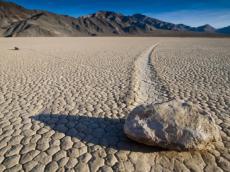|
|
TODAY.AZ / Weird / Interesting
Half-century mystery solved at last
01 September 2014 [14:42] - TODAY.AZ
 Ending a half-century of geological speculation, scientists have finally seen the process that causes rocks to move atop Racetrack Playa, a desert lake bed in the mountains above Death Valley, California. Half-century mystery solved at lastResearchers watched a pond freeze atop the playa, then break apart into sheets of ice that — blown by wind — shoved rocks across the lake bed.
Ending a half-century of geological speculation, scientists have finally seen the process that causes rocks to move atop Racetrack Playa, a desert lake bed in the mountains above Death Valley, California. Half-century mystery solved at lastResearchers watched a pond freeze atop the playa, then break apart into sheets of ice that — blown by wind — shoved rocks across the lake bed.Until now, no one has been able to explain why hundreds of rocks scoot unseen across the playa surface, creating trails behind them like children dragging sticks through the mud.
“It’s a delight to be involved in sorting out this kind of public mystery,” says Richard Norris, an oceanographer at the Scripps Institution of Oceanography in La Jolla, California, who led the research with his cousin James Norris, an engineer at Interwoof in Santa Barbara, California. The work was published on August 27 in PLoS ONE.
Geologists previously speculated that some combination of wind, rain and ice would have a role. But few expected that the answer would involve ice as thin as windowpanes, pushed by light breezes rather than strong gales.
Visitors to Death Valley have to go out of their way to visit Racetrack Playa, which sits 1,130 meters above sea level and is a bumpy three-hour drive from the nearest town. The researchers began studying the region in 2011, setting up a weather station and time-lapse cameras and dropping off rocks loaded with Global Positioning System (GPS) trackers. The rocks were designed to start recording their position and speed as soon as something made them move.
Racetrack Playa rocks move rarely — “maybe a few minutes out of a million,” Lorenz says. And the two events the scientists saw, with thin ice panes shoving the stones across a wet playa, do not necessarily explain every instance of rocks moving there. “But this breaks the back of the problem scientifically,” Lorenz says. “It is ice shove.”
Solving the Racetrack Playa mystery is not exactly a major scientific breakthrough, Lorenz says, but the work does show the rare combination of conditions that allow rocks to move seemingly on their own. And ice shove can have notable effects — in 1952, it uprooted enough telephone poles at a lake in Nevada to break a transcontinental telephone line.
/AzerTAc/
URL: http://www.today.az/news/interesting/136551.html
 Print version
Print version
Views: 4833
Connect with us. Get latest news and updates.
See Also
- 19 February 2025 [22:20]
Visa and Mastercard can return to Russia, but with restrictions - 05 February 2025 [19:41]
Japan plans to negotiate with Trump to increase LNG imports from United States - 23 January 2025 [23:20]
Dubai once again named cleanest city in the world - 06 December 2024 [22:20]
Are scented candles harmful to health? - 23 November 2024 [14:11]
Magnitude 4.5 earthquake hits Azerbaijan's Lachin - 20 November 2024 [23:30]
Launch vehicle with prototype of Starship made its sixth test flight - 27 October 2024 [09:00]
Fuel prices expected to rise in Sweden - 24 October 2024 [19:14]
Turkiye strikes terror targets in Iraq and Syria - 23 October 2024 [23:46]
Kazakhstan supplied almost entire volume of oil planned for 2024 to Germany in 9 months - 23 October 2024 [22:17]
Taiwan reported passage of Chinese Navy aircraft carrier near island
Most Popular
 100 million is wasted: who pays for the fake history of the South Caucasus
100 million is wasted: who pays for the fake history of the South Caucasus
 New free trade accord reached between India and New Zealand
New free trade accord reached between India and New Zealand
 "Garegin's days are numbered" is another reminder warning to the Armenian Catholicos
"Garegin's days are numbered" is another reminder warning to the Armenian Catholicos
 Opening of regional communications: equating to TRIPP
Opening of regional communications: equating to TRIPP
 Azerbaijan’s FM honors Colombian Ambassador as he concludes mission
Azerbaijan’s FM honors Colombian Ambassador as he concludes mission
 Final statements delivered in trial of Armenian citizens at Baku Military Court
Final statements delivered in trial of Armenian citizens at Baku Military Court
 Presentation of 'Asaf Zeynalli Selected Works' held online from Australia
Presentation of 'Asaf Zeynalli Selected Works' held online from Australia
